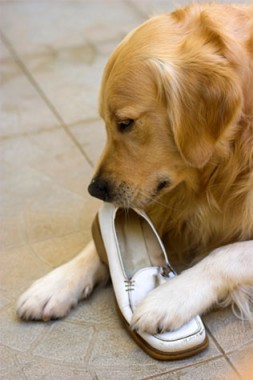Dog Breeds Originating From Scotland
Herding Dogs
The bearded collie, as far back as 1600s, was bred for hill shepherding. His elegant, long coat provided protection against harsh weather, like that of of the rough collie or Lassie dog. A miniature Lassie lookalike is the Shetland sheepdog. The iconic herding dog, the intelligent and energetic border collie, originated in the wild Scottish/English border country.
Sporting Dogs
Another old breed from Scotland is the rough-coated border terrier. The West Highland white terrier was bred to be visible in the heather on shoots. The cairn terrier was named after the stone cairns across Scotland. Three U.S. presidents have owned Scottish terriers, affectionately known by enthusiasts as Scotties. Other sporting breeds from Scotland include the golden retriever, bred as a gun dog to retrieve duck and upland game, the Gordon setter and the Scottish deerhound, the hunting dog of the Scottish Chieftains.
Chewing and Destruction

Let’s first look at why dogs chew. Puppies have sharp little “milk teeth” and not only do puppies enjoy chewing as a means to relieve stress but they need to chew to alleviate aching gums and later to loosen those teeth when it is time to fall out. Some puppies can teethe until they are 9 to 12 months although many will be finished and have a complete set of adult teeth by this time.
Older dogs should have acceptable chew objects to keep those teeth healthy. Certainly not all chew toys are created equal so ask your veterinarian for recommendations for safe and effective chew objects. When adult dogs chew on appropriate items it can be like us flossing. It cleans excessive plaque off the teeth and feels pretty good. They were given strong jaws and teeth to chew through bones. Nature would have these opportunistic scavengers getting nutrition wherever they could find it. So bones have a lot of value to them. It is important to give bones that are suitable for dogs. Consult your veterinarian for ideas on using bones to make sure they are appropriate size and type for your dog. You should never give cooked fowl bones to dogs because of the high risk of choking and splintering.
We now know not only do dogs enjoy chewing but they need to for a number of different reasons. Outside of the desire to chew, dogs explore the world through scent and by using their mouths. We pick up objects, eat and play by using our hands. Dogs use their mouth for all three of these activities. When you bring a new dog into your home whether it is a puppy or adult you should follow a few key steps to make sure they don’t chew on the wrong things.
STEP 1: PROOFING YOUR HOME.
Make sure anything that is valuable or dangerous is put away when you bring a dog home (shoes, electric cords, toxic plants, dish towels, etc). Get down on the ground and look for anything hanging down that looks like it would be fun for a dog to play with or chew.
STEP 2: FIND TOYS.
Find objects that the dog likes to chew on (toys,appropriate sized bones that do not splinter, puzzle and feeder toys) and praise your dog every time he chooses the correct objects to put in his mouth.
STEP 3: EXERCISE.
Alleviate a bored dog and anxious mind by giving your dog a big exercise outlet prior to down time, preferably one where he can use his mouth in a positive way like fetch and structured tug games.
STEP 4: DROP IT.
Teach your dog a solid “drop it” command so when he picks the wrong object he is happy to let it go for another object or treat.
After a few weeks the dog will develop a routine of the objects he likes to put in his mouth. Keep mixing up the routine by adding objects and hide old favorites from time to time so when you bring it back he thinks, “oh yeah, I forgot about that one, I love that”. The best defense against chewing and destruction is a good offensive game plan. Show your dog what kinds of objects are acceptable to chew and you will prevent a lot of destruction and unnecessary frustration.





